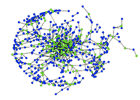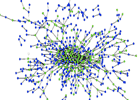Drawing Networks
-
Circular Layout

Pajek, a common network analysis package, begins by reading a network data file with all nodes and arcs or edges and displaying them in a circle. In this stage, nodes are arranged by number around the circle.
-
Nodes begin movement

After drawing the circular layout, Pajek energizes the network. It does this by moving nodes that are connected towards each other, and spreading nodes that are not connected away from each other.
-
Nodes continue movement

Continuing motion brings nodes closer to their final position. The graph no longer keeps its circular shape, and it is clear that some nodes are going to remain in the center, while others will remain on the outskirts.
-
Energized network

In its final stage, the graph has reached equilibrium between the pulling of connected nodes and the pushing of unconnected nodes. This visually depicts all information contained within a network and can be used, along with advanced mathematical techniques, for analysis.
Energization
The easiest way to understand how a network is energized is to think of the nodes as atoms - protons and electrons. Certain atoms will be attracted and want to be close to each other, while certain others will want to be far away from each other. If a network were made of all atoms that were attracted to each other, they would converge onto one point. If it were made of all atoms that repelled each other, they would shoot off in opposite directions until infinitely far away from each other. However, if some atoms want to be close to each other and others want to be far apart, then there must be some balance between the two.
Energizing a network naturally moves nodes which are attracted (or connected) to many others toward the middle, and nodes which are repelled (or unconnected) to the outside. Formally, energizing a network is an application of Hook’s law and the Principle of minimization of potential energy. Connected nodes minimize potential energy by having no distance between them, while unconnected nodes minimize potential energy by having infinite distance between them. An energized network minimizes the potential energy of the entire system by minimizing the potential energy of all individual connections.
The two most common energizing algorithms are the Kamada-Kawai and Fruchterman-Reingold algorithms. These two energization methods use the same principle, but differ in optimal spacing of nodes and the number of iterations run in the drawing algorithm. Generally, Fruchterman-Reingold is considered more applicable to large networks, 500 nodes or more, and Kamada-Kawai is more commonly used to draw smaller networks. It is important to note that, while these methods differ slightly in their drawing characteristics, there is no analytical difference between them.
Learn about statistical network measures...
Source
Katz, Daniel Martin, Stafford, Derek K. and Provins, Eric A., Social Architecture, Judicial Peer Effects and the 'Evolution' of the Law: Toward a Positive Theory of Judicial Social Structure (October 4, 2008). Georgia State Law Review, Vol. 23, 2008.